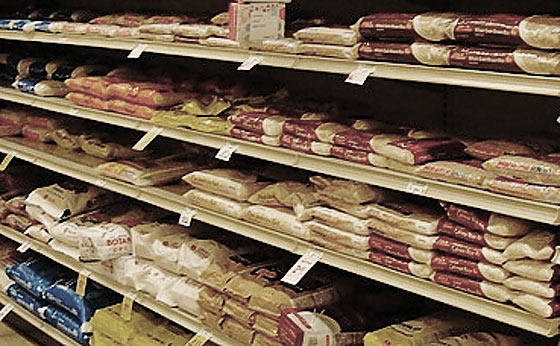Is It Safe To Store Rice & Beans In Original Bags If In Food Buckets?

I recently received the question, “Is it safe to keep beans and rice in bags they are bought in if stored in food buckets?”.
That’s a very good question. Here’s my opinion…
The first keyword is ‘safe’. My general answer is sure, it’s safe, with a few caveats…
1. Brown rice will go rancid after awhile because it contains oils. Figure about one year and you may taste the effects. Fortunately our sense of smell and taste will alert us to rancidity – and therefore we will be cued not to eat it.
2. White rice will store MUCH MUCH longer (although brown rice is arguably more healthy ;) )
3. As dried beans get older, they become harder to soften during the cooking process. But they remain ‘safe’.
3. If within the original question there is an implication of safety regarding the original store-bought packaging of rice and/or beans (typically a plastic bag), the plastic wrapping itself will be ‘food-grade’ due to regulations – therefore determined ‘safe’. With that said, the nature of the plastic would be the least of my concerns in a survival scenario whereby I’m looking to consume calories…
The second keyword phrase ‘food buckets’ implies a desire for long-term storage.
1. The four things that affect long term food storage are temperature, moisture content, atmosphere, and the container.
2. Food buckets will help keep rodents and bugs out, and the buckets (with lids) will enable a sealed environment. Even though one might keep their rice & beans in their original packaging (and then kept in food buckets), if you’re looking for optimal successful long term food storage (years) then you will need to remove oxygen from the environment via oxygen absorbers (typically 2000 cc’s per 5-gallon bucket). But then we’re talking about using a Mylar bag and oxygen absorbers – which gets away from the original question regarding store-bought bags and simply being kept in food buckets…
3. It is generally recommended to first freeze (for 24 – 48 hours) bags of rice which will kill off any existing ‘bugs’. Let rest at room temperature for several days after removing from the freezer in order for the resulting condensation (upon removal) to evaporate before sealing into any container.
4. Here’s how I’m storing my dry beans. The method (vacuum sealed bags) allows me to store a large variety of beans and legumes without having to buy large bulk quantities of each variety (which would then be stored in 5-gallon pails with Mylar bags and oxygen absorbers).
In conclusion, if you’re looking for long term success at food storage of rice and beans, they should be stored in oxygen-free environments. With that said, you will still get years of usability from having simply placed individual store-bought bags inside food buckets (especially if using the freezer method first – to kill off any bugs).
Here’s a question for you readers out there…
For those of you who have simply kept white rice and/or dry beans for years without any particular long-term storage precautions (oxygen-free environment in Mylar bags, etc..), what have been your results?
